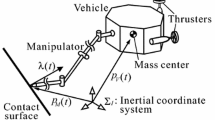Abstract
This paper deals with a control scheme for underwater vehicle-manipulator systems with the dynamics of thrusters in the presence of uncertainties in system parameters. We have developed two controllers that overcome thruster nonlinearities, which cause an uncontrollable system: one is a regressor-based adaptive controller and the other is a robust controller. However, the structure of the adaptive controller is very complex due to the feedforward terms including the regressors of dynamic system models, and the error feedback gains of the robust controller with a good control performance are excessively high due to the lack of feedforward terms. In this paper we develop an adaptive controller that uses radial basis function networks instead of the feedforward terms. The replacement leads to a moderately high gain controller whose structure is simpler than that of the regressor-based adaptive controller.






Similar content being viewed by others
Abbreviations
- \( N_{\text{v}} \) :
-
Number of dimensions for motion of vehicle
- \( N_{\text{e}} \) :
-
Number of dimensions for motion of manipulator end-effector
- \( N_{n} \) :
-
Number of dimensions for motion of vehicle and manipulator end-effector (i.e., \( N_{\text{v}} + N_{\text{e}} \))
- \( N_{\text{a}} \) :
-
Number of dimensions for vehicle’s orientation and manipulator’s joint angles
- \( N_{\text{m}} \) :
-
Number of links (we will assume in Sect. 2 that \( N_{\text{m}} = N_{\text{e}} \))
- \( x\left( t \right) \) :
-
Signal composed of vehicle’s and manipulator end-effector’s positions and orientations (\( \in R^{{N_{n} }} \))
- \( \phi (t) \) :
-
Signal composed of vehicle’s orientation and manipulator’s joint angles \( \left( { \in R^{{N_{\text{a}} }} } \right) \)
- \( u(t) \) :
-
Signal composed of vehicle’s translational velocity and \( \dot{\phi }(t) \) \( \left( { \in R^{{N_{n} }} } \right) \)
- \( \tau_{\text{m}} (t) \) :
-
Joint torques of manipulator \( \left( { \in R^{{N_{\text{m}} }} } \right) \)
- \( J(\phi ) \) :
-
Jacobian matrix in the equation \( \dot{x}(t) = J(\phi )u(t) \) \( \left( { \in R^{{N_{n} \times N_{n} }} } \right) \)
- \( \bar{R}(\phi ) \) :
-
Transformation matrix from thrust forces to force and torque concerning inertial coordinate system \( \left( { \in R^{{N_{\text{v}} \times N_{\text{v}} }} } \right) \)
- \( \bar{M}(\phi ) \) :
-
Inertia matrix \( \left( { \in R^{{N_{n} \times N_{n} }} } \right) \)
- \( \bar{f}( \cdot ) \) :
-
Signal composed of centrifugal, Coriolis, gravitational and buoyant forces, and fluid drag \( \left( { \in R^{{N_{n} }} } \right) \)
- \( v(t) \) :
-
Shaft velocities of thruster’s propellers \( \left( { = [v_{1} (t), \ldots ,v_{{N_{\text{v}} }} (t)]^{\text{T}} \in R^{{N_{\text{v}} }} } \right) \)
- \( \tau_{\text{b}} (t) \) :
-
Shaft torques of thruster’s propellers \( \left( { \in R^{{N_{\text{v}} }} } \right) \)
- \( A,\;B,\;\bar{K} \) :
-
Diagonal matrices composed of thruster’s system parameters \( \left( { \in R^{{N_{\text{v}} \times N_{\text{v}} }} } \right) \)
- \( \text{sgn} ( \cdot ) \) :
-
Signum function
- \( \exp ( \cdot ) \) :
-
Exponential function (e.g., \( \exp (x) = e^{x} \))
- \( {\text{diag}}\{ \cdot \} \) :
-
Diagonal matrix (e.g., \( {\text{diag}}\{ a_{1} , \ldots ,a_{n} \} \) where \( a_{i} \) are diagonal elements)
- \( {\text{tr}}\{ \cdot \} \) :
-
Trace of matrix
References
Antonelli G (2003) Underwater robots: motion and force control of vehicle-manipulator systems. Springer, Berlin
Canudas de Wit C, Diaz EO, Perrier M (2000) Nonlinear control of an underwater vehicle/manipulator with composite dynamics. IEEE Trans Control Syst Technol 8(6):948–960
Taira Y, Oya M, Sagara S (2010) An adaptive controller for underwater vehicle-manipulator systems including thruster dynamics. In: Proceedings of the international conference on modelling, identification and control, pp 185–190
Taira Y, Sugino J, Takagi N, Oya M (2011) Robust controller for underwater vehicle- manipulator systems including thruster dynamics. In: Proceedings of the 16th international symposium on artificial life and robotics, pp 134–137
Haykin S (1999) Neural networks: a comprehensive foundation, 2nd edn. Prentice-Hall, Englewood Cliffs, pp 256–317
Yoerger DR, Cooke JG, Slotine JJE (1990) The influence of thruster dynamics on underwater vehicle behavior and their incorporation into control system design. IEEE J Ocean Eng 15(3):167–178
Krstic M, Kanellakopoulos I, Kokotovic P (1995) Nonlinear and adaptive control design. Wiley, New York
Ioannou PA, Sun J (1996) Robust adaptive control. Prentice Hall, Englewood Cliffs, p 75
Bachmayer R, Whitcomb LL, Grosenbaugh MA (2000) An accurate four-quadrant nonlinear dynamical model for marine thrusters: theory and experimental validation. IEEE J Ocean Eng 25(1):146–159
Author information
Authors and Affiliations
Corresponding author
About this article
Cite this article
Taira, Y., Oya, M. & Sagara, S. Adaptive control of underwater vehicle-manipulator systems using radial basis function networks. Artif Life Robotics 17, 123–129 (2012). https://doi.org/10.1007/s10015-012-0023-7
Received:
Accepted:
Published:
Issue Date:
DOI: https://doi.org/10.1007/s10015-012-0023-7




